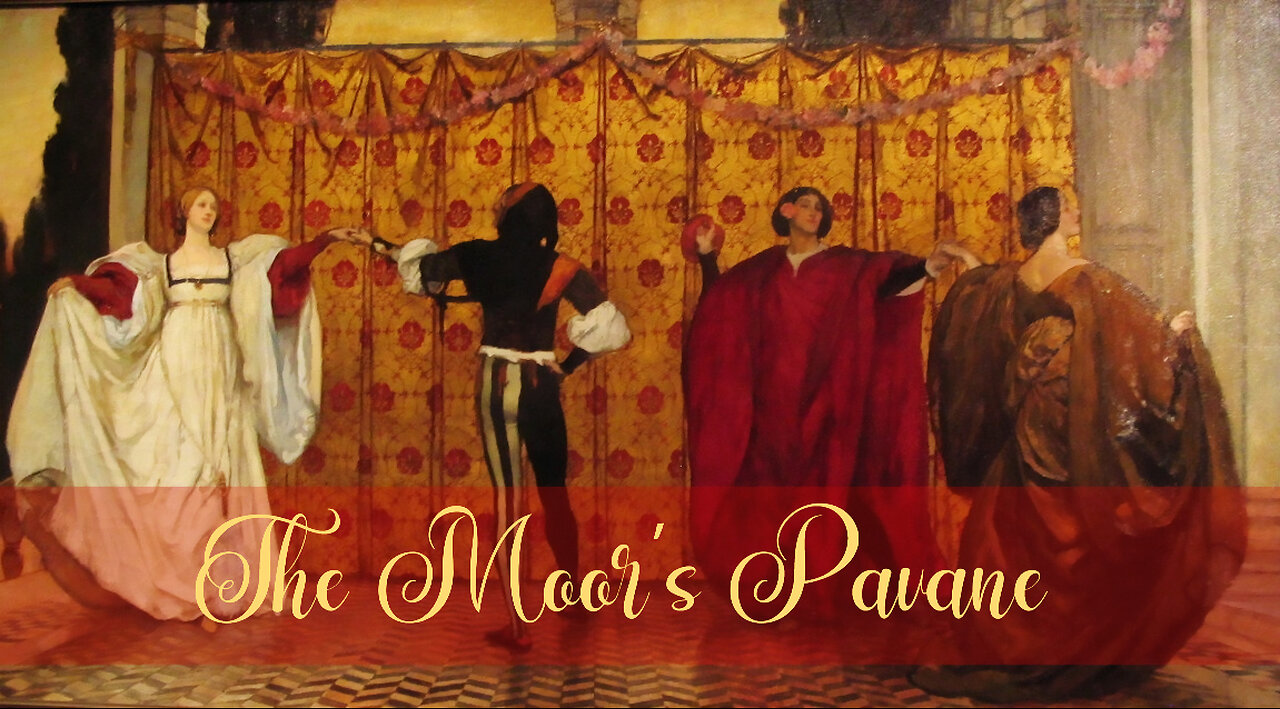Premium Only Content

The Moor's Pavane - Variations on the Theme of Othello (Leningrad Conservatory Theater 1985)
Pavane, (probably from Italian padovana, “Paduan”), is a slow majestic processional dance common in Europe during the 16th century (Renaissance). Until about 1650 the pavane opened ceremonial balls and was used as a display of elegant dress. Adapted from the basse danse, an earlier court dance, the pavane presumably traveled from Italy to France and England by way of Spain; in southern Spain it was performed in churches on solemn occasions. Although the dance is often associated with Spain, it was "almost certainly of Italian origin".
The pavane, the earliest-known music for which was published in Venice by Ottaviano Petrucci, in Joan Ambrosio Dalza's Intabolatura de lauto libro quarto in 1508, is a sedate and dignified couple dance, similar to the 15th-century basse danse. Later composers occasionally used the pavane as an instrumental piece; e.g., Fauré (Pavane for Orchestra) and Ravel (Pavane for a Dead Princess).
Composer: Henry Purcell
Choreography: Jose Limon, N. Dolgushin
Director: E. Popova
Performers:
Moor - Andres Williams
Moor's Wife - Svetlana Smirnova
Friend - Nikita Dolgushin
Friend's Wife - Gabriella Komleva
Symphony Orchestra of the Leningrad Conservatory
Conductor: V. Chernushenko
The dance performance was composed by José Limón to the music of the famous English composer Henry Purcell (1659-1695) for the plays “The Gordian Knot Untied”, “Abdelazar”, as well as the pavane from the play “Pavane and Chaconne for String Instruments” (arranged by Simon Sadove). The premiere of "The Moor's Pavane", shown for the first time at the American Dance Festival, was danced by: Jose Limon (Moor), Betty Jones (Moor's Wife), Lucas Hoving (Friend), Pauline Kohner (Friend's Wife).
The ballet's subtitle, "Variations on the Theme of Othello," does not mean that it is a staging of Shakespeare's tragedy. "The Moor's Pavane" is a dance for two couples, which seems to take the form of a traditional pavane: a slow dance, where the performers in period costumes, solemnly change places, coming together and moving apart, sometimes holding hands, and communicating with each other in a reserved manner. At the same time, without violating the "court" ritual, the twists and turns of Shakespeare's tragedy are played out. At the moment when the Moor and Iago (called the Friend in the ballet) are next to each other, the Friend, leaning his hands on the Moor's shoulders from behind, seems to subjugate him, whispering slander. And now the Moor, poisoned by the poison of slander, goes to meet the Wife (as Desdemona is called here), and casts hostile glances at her. The Friend's Wife is at first outraged by her husband's intrigues, but then is forced to submit to them. And now the handkerchief dropped by the Moor's Wife, passing from hand to hand, becomes evidence. Jealousy, bewilderment, entreaty, fear, rage and despair - all these feelings are conveyed in leisurely bows, changes of partners, touching hands, turning heads, bending the body. Revealing the essence of Shakespeare's tragedy in dance, the choreographer insists on a more general understanding of the performance: a similar story is possible in the life of any person.
-
 25:19
25:19
Adaneth - Arts & Literature
1 month agoClassical Destinations I | St, Petersburg: Shostakovich & Tchaikovsky (Episode 13)
472 -
 LIVE
LIVE
StoneMountain64
2 hours agoAnswering BATTLEFIELD 6 Questions and Reviewing TOP Clips (BETA DOWNLOADED)
251 watching -
 LIVE
LIVE
Jeff Ahern
42 minutes agoMonday Madness with Jeff Ahern
91 watching -
 1:11:30
1:11:30
Sean Unpaved
2 hours agoCowboys Chronicle: Jerry Jones, Micah Parsons, & the NFC East Battle
20.6K -
 1:53:23
1:53:23
Tucker Carlson
2 hours agoMargaret Roberts Exposes the True Story of the Oklahoma City Bombing and the Ongoing Cover-Up
20.3K50 -
 6:09:03
6:09:03
JuicyJohns
6 hours ago $2.20 earned🟢#1 REBIRTH PLAYER 10.2+ KD🟢$500 GIVEAWAY SATURDAY!
60.7K2 -
 LIVE
LIVE
Viss
3 hours ago🔴LIVE - The Energy, The Tactics, and The Knowledge You Need To Win! - PUBG
151 watching -
 1:00:44
1:00:44
RalliedLIVE
1 hour agoWARZONE CHALLENGES WITH DRDISRESPECT & BOB
1.88K1 -
 1:01:03
1:01:03
Timcast
3 hours agoDemocrats SABOTAGE Texas REDISTRICTING, May Be CHARGED
160K129 -
 1:59:07
1:59:07
The Charlie Kirk Show
3 hours agoTexas Dems In Flight + Recess Appointments Or Not? | Sen. Mullin, Halperin, Sen. Scott | 8.4.2025
65.7K19